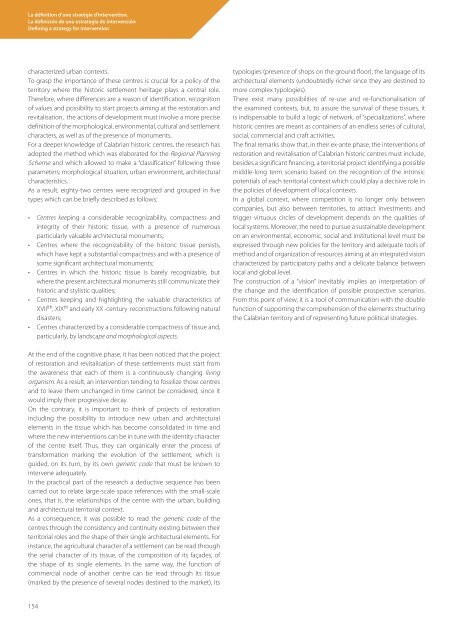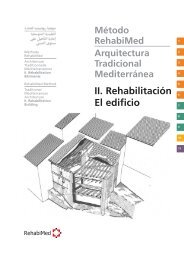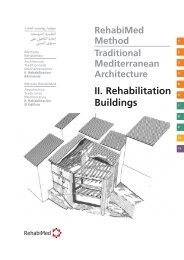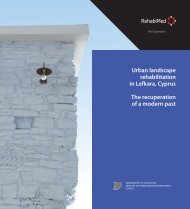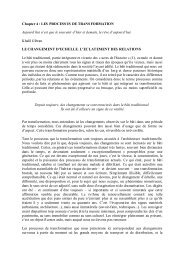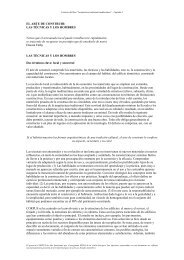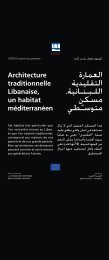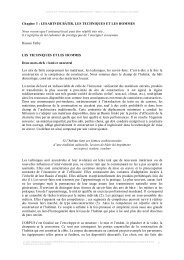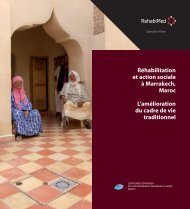La définition d'une stratégie d'intervention. La ... - RehabiMed
La définition d'une stratégie d'intervention. La ... - RehabiMed
La définition d'une stratégie d'intervention. La ... - RehabiMed
You also want an ePaper? Increase the reach of your titles
YUMPU automatically turns print PDFs into web optimized ePapers that Google loves.
<strong>La</strong> <strong>définition</strong> d’une <strong>stratégie</strong> d’intervention.<br />
<strong>La</strong> definición de una estrategia de intervención<br />
Defining a strategy for intervention<br />
characterized urban contexts.<br />
To grasp the importance of these centres is crucial for a policy of the<br />
territory where the historic settlement heritage plays a central role.<br />
Therefore, where differences are a reason of identification, recognition<br />
of values and possibility to start projects aiming at the restoration and<br />
revitalisation, the actions of development must involve a more precise<br />
definition of the morphological, environmental, cultural and settlement<br />
characters, as well as of the presence of monuments.<br />
For a deeper knowledge of Calabrian historic centres, the research has<br />
adopted the method which was elaborated for the Regional Planning<br />
Scheme and which allowed to make a “classification” following three<br />
parameters: morphological situation, urban environment, architectural<br />
characteristics.<br />
As a result, eighty-two centres were recognized and grouped in five<br />
<br />
<br />
<br />
<br />
<br />
<br />
ping a considerable recognizability, compactness and<br />
integrity of their historic tissue, with a presence of numerous<br />
particularly valuable architectural monuments;<br />
<br />
which have kept a substantial compactness and with a presence of<br />
some significant architectural monuments;<br />
<br />
where the present architectural monuments still communicate their<br />
historic and stylistic qualities;<br />
<br />
XVII Ith , XIX th and early XX -century reconstructions following natural<br />
disasters;<br />
<br />
particularly, by landscape and morphological aspects.<br />
<br />
architectural elements (undoubtedly richer since they are destined to<br />
more complex typologies).<br />
There exist many possibilities of re-use and re-functionalisation of<br />
the examined contexts, but, to assure the survival of these tissues, it<br />
is indispensable to build a logic of network, of “specializations”, where<br />
historic centres are meant as containers of an endless series of cultural,<br />
social, commercial and craft activities.<br />
The final remarks show that, in their ex-ante phase, the interventions of<br />
restoration and revitalisation of Calabrian historic centres must include,<br />
besides a significant financing, a territorial project identifying a possible<br />
middle-long term scenario based on the recognition of the intrinsic<br />
potentials of each territorial context which could play a decisive role in<br />
the policies of development of local contexts.<br />
In a global context, where competition is no longer only between<br />
companies, but also between territories, to attract investments and<br />
trigger virtuous circles of development depends on the qualities of<br />
local systems. Moreover, the need to pursue a sustainable development<br />
on an environmental, economic, social and institutional level must be<br />
expressed through new policies for the territory and adequate tools of<br />
method and of organization of resources aiming at an integrated vision<br />
characterized by participatory paths and a delicate balance between<br />
local and global level.<br />
The construction of a “vision” inevitably implies an interpretation of<br />
the change and the identification of possible prospective scenarios.<br />
From this point of view, it is a tool of communication with the double<br />
function of supporting the comprehension of the elements structuring<br />
the Calabrian territory and of representing future political strategies.<br />
At the end of the cognitive phase, it has been noticed that the project<br />
of restoration and revitalisation of these settlements must start from<br />
the awareness that each of them is a continuously changing living<br />
organism. As a result, an intervention tending to fossilize those centres<br />
and to leave them unchanged in time cannot be considered, since it<br />
would imply their progressive decay.<br />
On the contrary, it is important to think of projects of restoration<br />
including the possibility to introduce new urban and architectural<br />
elements in the tissue which has become consolidated in time and<br />
where the new interventions can be in tune with the identity character<br />
of the centre itself. Thus, they can organically enter the process of<br />
transformation marking the evolution of the settlement, which is<br />
guided, on its turn, by its own genetic code that must be known to<br />
intervene adequately.<br />
In the practical part of the research a deductive sequence has been<br />
carried out to relate large-scale space references with the small-scale<br />
ones, that is, the relationships of the centre with the urban, building<br />
and architectural territorial context.<br />
As a consequence, it was possible to read the genetic code of the<br />
centres through the consistency and continuity existing between their<br />
territorial roles and the shape of their single architectural elements. For<br />
instance, the agricultural character of a settlement can be read through<br />
the serial character of its tissue, of the composition of its façades, of<br />
the shape of its single elements. In the same way, the function of<br />
commercial node of another centre can be read through its tissue<br />
(marked by the presence of several nodes destined to the market), its<br />
154


